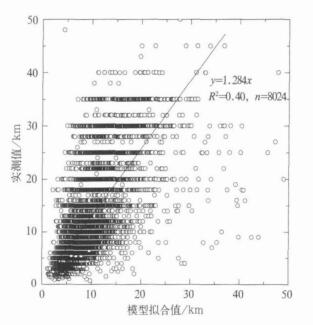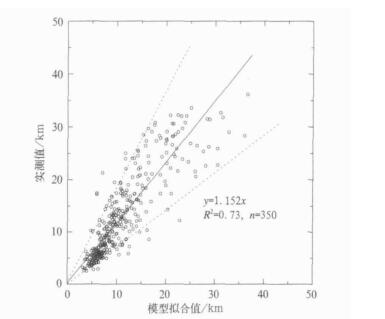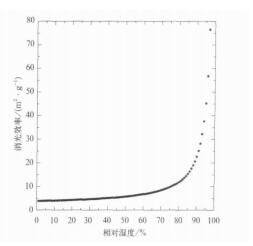深圳市大气能见度与细粒子浓度统计模型
Statistical Model of the Relationship Between Atmospheric Visibility and PM2.5 in Shenzhen
-
摘要: 利用深圳市2007年全年逐时能见度、PM2.5质量浓度和相对湿度观测数据, 在分析大气消光机理及其影响因素的基础上确立了能见度与PM2.5之间的基本模型关系, 着重讨论分析了相对湿度对颗粒物消光影响的常见修正方式, 并通过线性和非线性回归分析筛选相对湿度影响修正因子fRH的表达形式和确定模型参数, 最终建立起适合于深圳本地情况的能见度与PM2.5之间的最优统计模型 (R2=0.43, n=8024)。进一步利用能见度与PM2.5的日平均值进行了多元回归分析, 模型拟合值与实测值之间的相关系数 (R2) 高达0.73(n=350), 而且预测偏差范围小, 较好地反映了深圳市大气能见度与PM2.5之间的定量相关关系。Abstract: With the development of economy, the level of air quality in main cities of China has experienced a continuously deteriorating process. Pearl River Delta Region are confronting with the disturbance of more and more haze weather especially. As one of the cities with the most serious haze problem in the region, Shenzhen experiences 231 haze days in 2007 according to the definition of haze that visual range is lower than ten kilometers and relative humidity is not higher than 80% at the same time. The degradation of atmospheric visibility is mainly caused by the extinction effect of aerosol particles, especially of fine particles, including scattering by inorganic components and absorption by black carbon. The average concentration of fine particle (particle whose aerodynamic diameter is lower than 2.5 μm) in Shenzhen is as high as 53.4±37.3 μg·m-3 in 2007, which is a little lower than other main cities in China but two times higher than American national standard enacted by USEPA. Accordingly, the average visibility is as low as 13.4±9.3 km, and shows the same seasonal variation as fine particle concentration. However, few studies on the quantitative relationship between visibility and fine particles in Chinese cities are reported in the literature. Based on the analysis of the extinction mechanisms and relevant influential factors, statistic models are developed for describing the relationship between visibility and fine particles in the urban air of Shenzhen using multiple regression techniques. The data includes visual range acquired by visual observation, fine particles concentration generated by TEOM 1400a (an online instrument for monitoring the concentration of fine particles) and relative humidity (RH). All the data are monitored simultaneously in the year of 2007, and abnormal values are excluded before regression analysis. fRH is used to eliminate the light extinction of humidity to particles, and four usual forms of it are discussed too. Multiple linear and nonlinear regression methods are used for regression analysis and the initial values of parameters come from literatures for nonlinear regression. Finally, a power function form of fRH containing underlying physical mechanism of particles' extinction is selected to reflect humidity's effect due to good agreement and the compact form. The complete model expression is given at the same time. The correlative coefficient between the observed visibility values and the reconstructed visibility values using the best model is 0.40 for the 1-hour average data. The model for 24-hour average data is also established in the same form. The correlative coefficient reaches as high as 0.73, and the deviation of the reconstructed values is small, so the model can properly reflect a good relationship between visibility and fine particles concentration. In addition, the expression of extinction efficiency changing with relative humidity demonstrates the similar increasing patterns in existing study, and reasonably describes the relationship between extinction efficiency and relative humidity in Shenzhen.
-
表 1 不同fRH形式的模型拟合结果
Table 1 Regression models with different fRH forms

-
[1] 黄健, 吴兑, 黄敏辉, 等.1954—2004年珠江三角洲大气能见度变化趋势.应用气象学报, 2008, 19(1):61-70. http://qikan.camscma.cn/jams/ch/reader/view_abstract.aspx?file_no=20080111&flag=1 [2] 吴兑.霾与雾的区别和灰霾天气预警建议.广东气象, 2004(4):1-4. http://www.cnki.com.cn/Article/CJFDTOTAL-GDCX200404000.htm [3] 吴兑, 廖国莲, 邓雪娇, 等.珠江三角洲霾天气的近地层输送条件研究.应用气象学报, 2008, 19(1):1-9. http://qikan.camscma.cn/jams/ch/reader/view_abstract.aspx?file_no=20080102&flag=1 [4] Baik N J, Kim Y P, Moon K C. Visibility study in Seoul, 1993.Atmos Environ, 1996, 30(13): 2319-2328. doi: 10.1016/1352-2310(95)00443-2 [5] Chan Y C, Simpson R W, Mctainsh G H, et al. Source apportionment of visibility degradation problems in Brisbane (Australia) using the multiple linear regression techniques. Atmos Environ, 1999, 33(19):3237-3250. doi: 10.1016/S1352-2310(99)00091-6 [6] 宋宇, 唐孝炎, 方晨, 等.北京市能见度下降与颗粒物污染的关系.环境科学学报, 2003, 23(4):468-471. http://www.cnki.com.cn/Article/CJFDTOTAL-HJXX200304010.htm [7] 刘新民, 邵敏.北京市夏季大气消光系数的来源分析.环境科学学报, 2004, 24(2):185-189. http://www.cnki.com.cn/Article/CJFDTOTAL-HJXX200402001.htm [8] 束炯, 李丽, 张玮.大气污染对城市能见度影响研究的理论与实践.上海环境科学, 2003, 22(11):785-847. http://www.cnki.com.cn/Article/CJFDTOTAL-SHHJ200311017.htm [9] Kao A S, Friedlander S K. Frequency distributions of PM 10 chemical components and their sources.Environ Sci Technol, 1995, 29: 19-28. doi: 10.1021/es00001a003 [10] Watson J G. Visibility: Science and regulation. J Air Waste Manage, 2002, 52(6):628-713. doi: 10.1080/10473289.2002.10470813 [11] 罗慧, 李良序, 胡胜, 等.公路交通事故与气象条件关系及其气象预警模型.应用气象学报, 2007, 18(3):350-357. http://qikan.camscma.cn/jams/ch/reader/view_abstract.aspx?file_no=20070357&flag=1 [12] 徐鹏炜, 谭湘萍, 蔡菊珍,等. 杭州城市大气消光系数和能见度的影响因子研究.环境污染与防治, 2005, 27(6): 410-413. http://www.cnki.com.cn/Article/CJFDTOTAL-HJWR200506002.htm [13] Cohen A.Horizontal visibility and the measurement of atmospheric optical depth of lidar. Appl Optics, 1975, 14(12): 2878-2882. doi: 10.1364/AO.14.002878 [14] 孙鸿良, 何曦.RP1400(a) 测尘仪出现负值的原因分析.环境污染与防治, 2001, 23(2): 92-93. http://www.cnki.com.cn/Article/CJFDTOTAL-HJWR200102021.htm [15] 牛文, 何凌燕, 胡敏, 等.深圳冬、夏季大气细粒子及其二次组分的污染特征.中国科学(B辑), 2006, 36(02):173-180. http://www.cnki.com.cn/Article/CJFDTOTAL-JBXK200602011.htm [16] HeK, Yang F M, Ma Y L. Characteris tics of PM2.5 in Beijing, China. A tmos Environ, 2001, 35: 4959-4970. doi: 10.1016/S1352-2310(01)00301-6 [17] Ye B M, Ji X L, Yang H Z. Concentration and chemical composition of PM2.5 in Shanghai in one-year period. Atmos Environ, 2003, 37: 4223-4234. http://www.sciencedirect.com/science/article/pii/S1352231002009184 [18] 魏复盛, 滕恩江, 吴国平.我国4个大城市空气PM2.5, PM10污染及其化学组成.中国环境监测, 2001, 17(7): 1-6. http://www.cnki.com.cn/Article/CJFDTOTAL-IAOB2001S1000.htm [19] White W H, Roberts P T. On the nature and origins of visibility-reducing aerosols in the los angeles air basin.Atmos Environ, 1977, 11(9):803-812. doi: 10.1016/0004-6981(77)90042-7 [20] Kotchenruther R A, Hobbs P V, Hegg D A. Humidification factors for atmospheric aerosol off the mid-Atlantic coast of United States. J Geophy Res, 1999, 104(D2): 2239-2251. doi: 10.1029/98JD01751 [21] Neiburger M, Wurtele M G. On the nature and size of particles in haze, fog and stratus of the Los Angeles region. Chem Rev, 1949, 44: 321-335. doi: 10.1021/cr60138a005 [22] Kotchenruther R A, Hobbs P V. Humidification factors of aerosols from biomass burning in Brazil. J Geophy Res, 1998, 103(D24): 32081-32089. doi: 10.1029/98JD00340 [23] Liu X, Cheng Y, Zhang Y, et al. Influences of relative humidity and particle chemical composition on aerosol scattering properties during the 2006 PRD campaign. Atmos Environ, 2008, 42: 1525-1536. doi: 10.1016/j.atmosenv.2007.10.077 [24] Sisler J F, Huffman D, Latimer D A. IMPROVE Reports (1993): Spatial and Temporal Patterns and the Chemical Composition of the Haze in the United States: An Analysis of Data from the IMPROVE Network. 1988-1991[EB/OL], 1993. [http://vista.cira.colostate.edu/improve/Publications/Reports/1993/1993.htm.] [25] Malm W C, Day D E. Estimates of aerosol species scattering characteristics as a function of relative humidity. Atmos Environ, 2001, 35: 2845-2860. doi: 10.1016/S1352-2310(01)00077-2 [26] Appel B R, Tokiwa Y, Hsu J, et al. Visibility as related to atmospheric aerosol constituents. Atmos Environ, 1985, 19 (9):1525-1534. doi: 10.1016/0004-6981(85)90290-2 [27] Groblicki P J, Wolff G T, Countess R J. Visibility-reducing species in the Denver "Brown Cloud"-I. Relationships between extinction and chemical composition. Atmos Environ, 1981, 15(12): 2473-2484. [28] Cass G R. On the relationship between sulfate in air quality and visibility with examples in Los Angeles. Atmos Environ, 1979, 13(8):1069-1084. doi: 10.1016/0004-6981(79)90031-3 -


 设为首页
设为首页 加入收藏
加入收藏



 下载:
下载:


